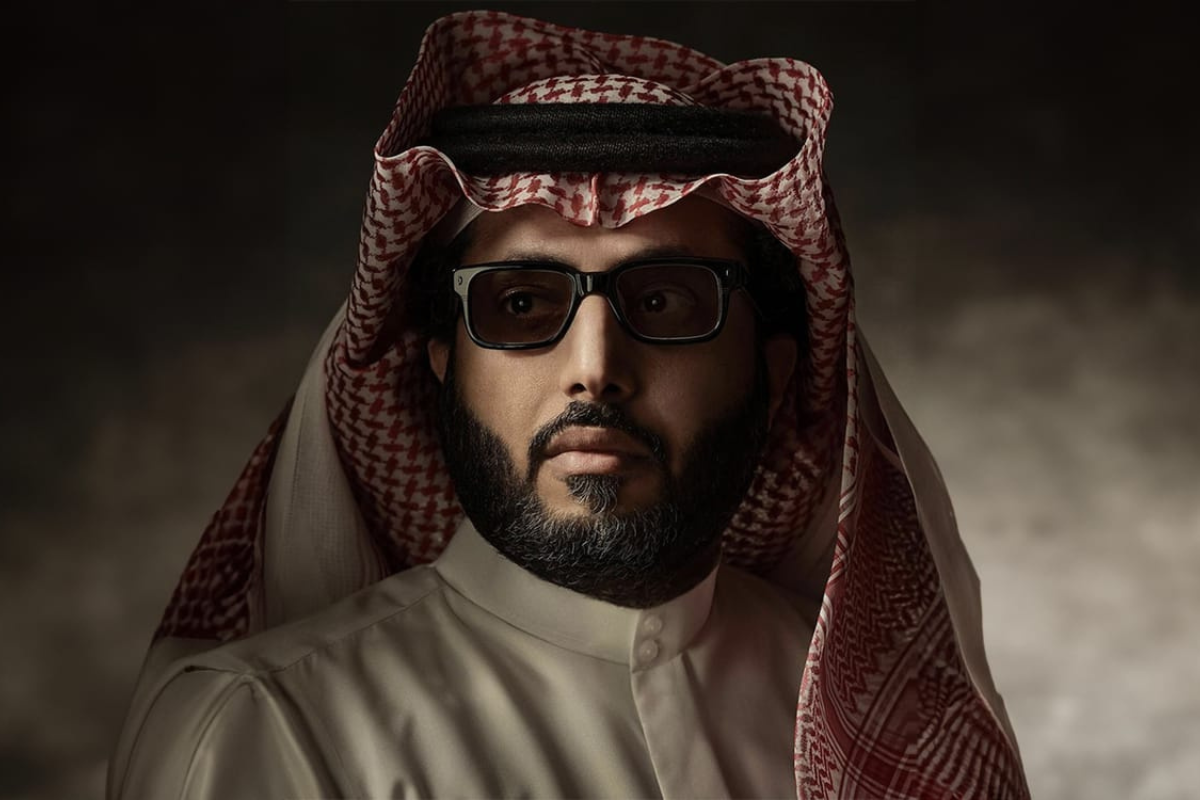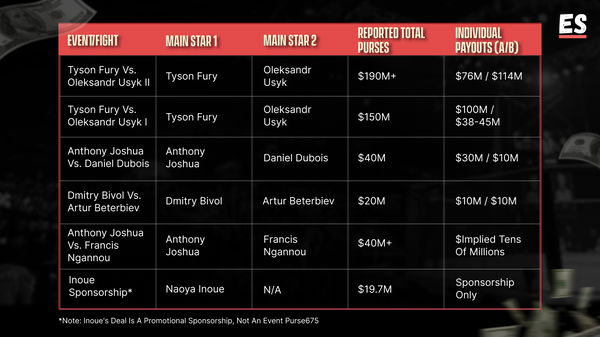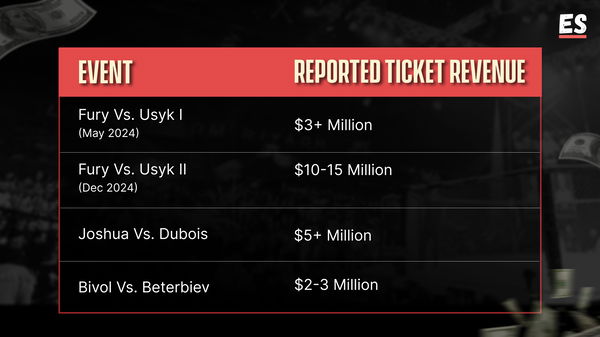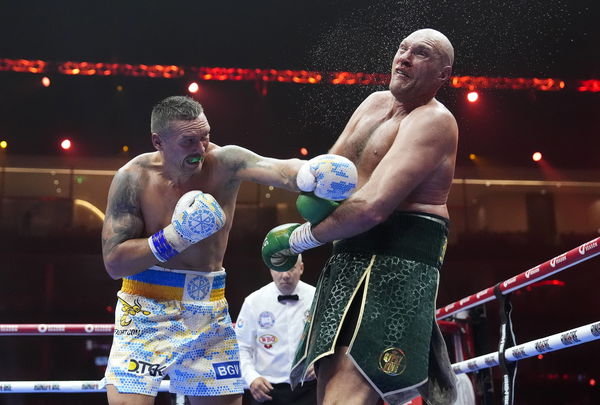

Only two weeks separate fans from what many call the greatest showdown since Floyd Mayweather fought Manny Pacquiao – the Canelo-Crawford fight. The flood of videos, debates, and op-eds on the September 13 clash at Allegiant Stadium is staggering. Yet away from that spotlight, as two of the best pound-for-pound fighters battle for the undisputed super middleweight title, another card is stirring diehards. On November 22, David Benavidez faces Anthony Yarde in a rare spectacle featuring five world titles on the line. These two events stand out as the most anticipated shows of the year.
Watch What’s Trending Now!
Riyadh Season has been the driving force behind this wave. From the Artur Beterbiev-Dmitry Bivol rematch to Chris Eubank Jr. vs. Conor Benn and the ‘Fatal Fury‘ series, it has staged the sport’s biggest, most lucrative events. In 2024, the Saudi Arabia-based festival, backed by the General Entertainment Authority, hosted a string of fight nights that lit up the sporting world. Under Turki Alalshikh‘s leadership, it now even hints at scrapping pay-per-view for future shows, adding intrigue to its model. So how does one organizer stage so many blockbusters and fuel talk of what some have called a ‘Saudi boxing takeover’?
ADVERTISEMENT
Round 1: Riyadh Season steps into the ring
Before looking at its role in boxing, it helps to understand what Riyadh Season is and what it aims to achieve. Riyadh Season is an event series run by Saudi Arabia’s General Entertainment Authority (GEA). It’s a key part of Vision 2030. Launched in 2016, the vision seeks to drive economic, cultural, and social diversification.

Imago
Tyson Fury vs Francis Ngannou press conference, PK, Pressekonferenz Tyson Fury vs Francis Ngannou kick off press conference held at Here at Outernet Charing Cross Road London uk 7.9.2023 Editorial Use Only, Credit:Dean Fardell / Avalon PUBLICATIONxNOTxINxUKxFRAxUSA Copyright: xDeanxFardellx/xAvalonx 0803631168
Held each year between October and March, Riyadh Season hosts concerts, music festivals, and, most notably, major sporting events. These range from soccer to combat sports, including Power Slap. By staging such large-scale shows, the organizers have reportedly fueled a surge of tourists and visitors to Saudi Arabia.
ADVERTISEMENT
Reports show Riyadh Season launched its first edition in 2019. But Saudi Arabia tested boxing earlier. On September 18, 2018, the city of Jeddah hosted a World Boxing Super Series final between George Groves and Callum Smith.
Top Stories
Jake Paul vs. Anthony Joshua Fight Purse: How Much Are Alycia Baumgardner and Others Earning?

Who Are Skye Bishop and Ally Brooke? Relationship Status, Net Worth, & Other details on Jake-Joshua National Anthem Singers

What Is Alycia Baumgardner’s Net Worth in 2025? Career Earnings, MVP Deal With Jake Paul, Biggest Purse & More

Is Jake Paul Puerto Rican? Nationality, Ethnicity, and Religion

Leila Beaudoin Relationship Status: Is the Canadian Boxer Married or Single?

A year later, on December 7, 2019, Diriyah Season, an offshoot of Riyadh Season, staged the much-anticipated Anthony Joshua vs. Andy Ruiz rematch. Three years later, on August 20, 2022, Oleksandr Usyk defended his title against Joshua in another major Saudi event.
ADVERTISEMENT
Riyadh Season’s true entry into boxing came on October 28, 2023. That night, under Turki Alalshikh’s leadership, the festival delivered Tyson Fury vs. Francis Ngannou in a landmark crossover fight.
Round 2: Riyadh’s superfights
What followed was a string of events that shook the sports world. Fans no longer looked only to Las Vegas or Wembley for the biggest fights. They now had another stage to reckon with.
ADVERTISEMENT
In 2024, the 26,000-seat Kingdom Arena opened and quickly became boxing’s new home. It hosted the undisputed heavyweight clash between Tyson Fury and Oleksandr Usyk. Later that year, the first four-belt light heavyweight title fight between Artur Beterbiev and Dmitry Bivol unfolded before the year ended with the Fury-Usyk rematch.
Beyond Saudi Arabia, Riyadh Season delivered high-octane action, including Daniel Dubois vs. Anthony Joshua at Wembley. Yet momentum kept shifting back to Riyadh. The November 22 card now looks set to cap the year and confirm Saudi Arabia as the sport’s new epicenter.
At a time when many believed boxing was in decline, Riyadh Season breathed new life into the sport.
ADVERTISEMENT
When the bell rings, the money flows
Still, questions remain: how does one promoter continue staging such spectacles, with mind-boggling purses and productions that leave fighters and fans in awe? Still, before we get into the nitty-gritty, it helps to see how top-tier boxers have benefited from Riyadh Season’s arrival.
Huge paydays for elite boxers are nothing new. The record-setting purses of Mayweather and Pacquiao remain untouched. Million-dollar fights were common even in the 1970s and 80s. Though dominated by NBA players, Forbes’ 2025 list of the 50 highest-paid athletes still ranks Tyson Fury at No. 3, with Usyk and Canelo also representing boxing.
ADVERTISEMENT
What has changed is the scale. Payouts surged to unprecedented levels once Riyadh Season entered the scene. Champions like Fury and Usyk began earning sums never seen before. What’s more, even second-tier stars started collecting purses once reserved only for legends.
The largest expense for Riyadh Season is fighter payouts. The breakdown is below:
- Tyson Fury: Up to $80-100 million per fight
- Oleksandr Usyk: $38-114 million per fight (varies by event and outcome)
- Anthony Joshua: $30-70 million per event depending on global rights
- Artur Beterbiev/Dmitry Bivol: $10 million each for top-level fights
- Daniel Dubois: $10 million for main events
ADVERTISEMENT
The December 2024 rematch between Tyson Fury and Oleksandr Usyk set new benchmarks in boxing economics. Their combined purse reportedly topped $190 million, with Usyk, as champion, taking 60%. Recent Riyadh Season payouts highlight the staggering scale:

ADVERTISEMENT
Beyond the ring, Riyadh Season signed a $19 million sponsorship deal with pound-for-pound star Naoya Inoue.
Riyadh Season spends heavily to attract international stars, even for supporting bouts. As a result, fighters who are not headliners still earn several million dollars. In the US and UK, fighter pay depends on ticket sales and pay-per-view buys. Thus, poor sales invariably mean smaller payouts. By contrast, Saudi Arabia’s General Entertainment Authority (GEA) guarantees fighters flat-fee contracts.
But the massive purses raise a question: how does Riyadh Season cover the rest of the bill? Beyond fighter payouts, costs include venue operations, security, logistics, production-broadcast teams, concerts-ceremonies, travel-hospitality, global marketing campaigns, and local government support.
The price of a spectacle
The Saudi government doesn’t just fund the events. It also spends heavily on marketing, luxury, and media to boost global reach. Unlike in the West, where promoters carry the risks, Riyadh Season boxing is directly underwritten by the General Entertainment Authority (GEA).
The government puts in tens of millions extra for things like
- Global marketing campaigns (billboards, ads worldwide)
- Luxury VIP experiences
- High-end production (custom staging, special effects)
- Media/influencer partnerships to boost visibility
- Making life easier for promoters (waiving fees, cutting red tape)
In the US and UK, promoters usually pay their own way. Riyadh Season is different. Though backed by the state, it raises an obvious question: how does it make money?
How does Riyadh Season earn?
Tickets
The main revenue source is ticket sales. Tickets sell locally and through international outlets, both online and offline. Regular seats and premium VIP packages generate strong income for the Saudi-based promotion. Here’s a look at recent key event sales.

One should note. Ticket revenue in Riyadh could be lower than in Las Vegas or London. Saudi organizers keep prices accessible to ensure packed arenas and broader inclusion. There are reports of subsidizing VIP seats for international guests. In contrast, Vegas superfights can earn $20-30 million at the gate due to higher pricing and resale inflation.
Venue
Then, the main boxing venue for Riyadh Season is the $1.3 billion Kingdom Arena in Riyadh. Hosting shows there helps cut costs. Since the arena is government-built and operated, expenses like security, utilities, and setup are treated as internal, not billed at market rates. This gives organizers more budget flexibility.
Pay-Per-View (PPV) and Broadcast Rights
The next major revenue streams are broadcast rights and PPV sales. In 2024–2025, these were Riyadh Season’s biggest cash generators per event:
PPV Revenues:
- Fury vs. Usyk I (May 2024): 1.5–1.6 million buys leading to $50–90 million
- Fury vs. Usyk II (Dec 2024): 2.2 million buys netted $150 million+
- Average undercards: 200–500k buys raked in $5–20 million
PPV prices typically range from $25 in the UK to $40 in the US. As most fans know, Riyadh Season distributes its fights through streaming platforms such as DAZN, TNT–Sky Sports, and ESPN.
But that model could potentially change. In July, Turki Alalshikh announced a shift away from pay-per-view. The move, already affecting the Canelo-Crawford showdown, means future fights may air under standard subscription rates on services like DAZN and even Netflix. This change will lower per-event PPV income but could expand the global audience.
My brother Mark Shapiro, great to see we share the same vision for fights and how our fans consume them. As I said one month ago with DAZN, PPV is a broken model and we must offer boxing events to fight fans at no additional cost. 🙏 🥊 pic.twitter.com/5Rdm6Rqtae
— TURKI ALALSHIKH (@Turki_alalshikh) August 12, 2025
Riyadh Season boxing is already broadcast worldwide on DAZN, ESPN, and Sky. Each major fight brings an estimated $20–40 million in broadcast rights. Even as the system transitions to DAZN’s subscription model, competition among multiple broadcasters keeps revenues strong and guarantees massive reach.
Brand sponsorship, partnerships, and commercial income
Major global brands like Monster, Red Bull, and Crypto.com spend millions to sponsor fights, advertise in arenas, and run global campaigns. Sponsorships alone can generate more than $40 million per event. Thus, Riyadh Season now rivals Las Vegas and London as a commercial boxing hub.
Boxing also drives a surge in Saudi tourism. Reports suggest Riyadh Season attracts over 18 million visitors annually. It contributes more than $1 billion in tourism revenue. Hotels, restaurants, transport, and retail see record demand during fight weeks. In turn, the surge has helped create tens of thousands of jobs. Boxing’s exact share is hard to measure. However, the biggest cards are clearly the main draw for high-spending international fans.
The GEA covers many costs, such as marketing and operations. This reduces risks for promoters and fighters. So instead of quick profit, long-term investment in tourism, global reputation, and economic diversification remains the goal.
The bottom line
Most major boxing shows in Riyadh aren’t built for direct profit. Costs per card can reach $180-250 million and usually only match revenues. The true return comes through tourism, global branding, soft power, and long-term growth in sports and entertainment. Government subsidies make this possible as a strategic bet rather than a short-term business.

Imago
Tyson Fury v Oleksandr Usyk – Kingdom Arena Oleksandr Usyk left lands a punch on Tyson Fury during the Heavyweight Championship fight at Kingdom Arena, Riyadh. Picture date: Saturday May 18, 2024. RESTRICTIONS: Use subject to restrictions. Editorial use only, no commercial use without prior consent from rights holder. PUBLICATIONxNOTxINxUKxIRL Copyright: xNickxPottsx 76230531
Compared to UFC or WWE, Riyadh Season pays far higher purses, making boxing the top spectacle sport. With new partnerships, Saudi Arabia is also building capacity for league-style recurring events, expanding beyond boxing into a wider sports hub.
The final bell & beyond
Since 2021, Saudi Arabia has invested over $6 billion in sports under Vision 2030. Through entertainment and sports, it aims to add $23 billion to GDP and create more than 70,000 jobs. Thus, boxing plays a key role. Not only does it bring instant global recognition and attract superstar athletes, but it also delivers events that mix sport with entertainment, culture, and celebrity.
Clearly, Riyadh Season has shifted boxing’s global center of gravity to the Gulf. While direct profits may rely on government support, the strategy is clear: use mega-events to drive tourism, strengthen global influence, and cement Saudi Arabia’s identity as the new ‘fight capital of the world.’
ADVERTISEMENT
ADVERTISEMENT
ADVERTISEMENT

